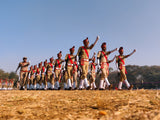Gatka – The Sikh Martial Art
Gatka is a traditional form of Sikh martial art. It involves the use of various weapons, including swords, spears, shields, and sticks, and is practiced as a means of physical, mental, and spiritual training.
Historically, Gatka played a significant role in Sikh culture, as it was used to defend the Sikh community from outside threats and persecution. During the early days of Sikhi, when the Sikh community was facing persecution from the Mughal rulers, Gatka was used as a means of self-defense. The Sikh Gurus themselves were skilled in Gatka and encouraged its practice among their followers.
Gatka also played a role in the Sikh rebellion against the British colonial rule in India. Sikh warriors who were skilled in Gatka fought against the British during the Indian Rebellion of 1857 and later during the Indian independence movement.
Today, Gatka is practiced as a form of physical exercise and spiritual discipline, as well as a way to preserve Sikh heritage and culture. It is often performed during festivals and other cultural events, and many Sikh youth are taught Gatka as a means of connecting with their heritage and traditions.
Origins and History of Gatka

Gatka is believed to have originated in the Punjab region of India, which was the birthplace of Sikhi. The region has a long history of martial arts, with various fighting styles being practiced by different communities.
Gatka was initially developed as a means of self-defense by the Sikh community, which faced persecution from the Mughal rulers in the 17th century. The Sikh Gurus themselves were skilled in various forms of combat, including Gatka, and they encouraged its practice among their followers. Guru Hargobind, the sixth Sikh Guru, was known to have trained his followers in Gatka to defend themselves against the Mughals.
Over time, Gatka evolved into a more organized system of training, with specific techniques and weapons being developed. The Sikh Misls, which were essentially confederacies of Sikh warrior bands, played a significant role in the development and spread of Gatka.
During the 18th and 19th centuries, Sikh warriors who were skilled in Gatka played a crucial role in various battles and wars, including the Anglo-Sikh Wars and the Indian Rebellion of 1857. They also fought against bandits and other criminals who posed a threat to local communities.
In the early 20th century, with the decline of the Sikh Empire and the rise of British colonial rule in India, Gatka began to lose its practical significance as a means of self-defense. However, it continued to be practiced as a way of preserving Sikh culture and heritage.
Techniques and Forms in Gatka

Gatka incorporates various techniques and weapons. Some of the fundamental techniques used in Gatka include footwork, strikes, and blocks. Footwork in Gatka involves moving around the opponent in a circular or zigzag pattern while maintaining balance and stability. The practitioner must be able to move quickly and smoothly to evade attacks and position themselves for an effective strike.
Strikes in Gatka include various forms of punches, kicks, and strikes with weapons such as sticks and swords. These strikes can be executed in different directions and with different levels of force, depending on the situation.
Blocks in Gatka involve using defensive techniques to deflect or stop an opponent's attack. Blocks can be executed with different parts of the body, including the arms, legs, and weapons.
There are different forms of Gatka, each with its own set of techniques and weapons. Some of the most common forms include:
- Single-stick Gatka: This form of Gatka involves the use of a single stick (wooden stick or cane) as a weapon. It is also known as "Ek Lathi" or "Ek Gathiya" in Punjabi, which means "one stick." The practitioner must be skilled in both offensive and defensive techniques. One of the key features of single-stick Gatka is the use of a specific type of stick known as a "gatka," which is made from a sturdy wood such as oak, bamboo, or hickory. The stick is typically around three to four feet long and is tapered at the ends for ease of use.
- Double-stick Gatka: In this form of Gatka, the practitioner uses two sticks as weapons. It is also known as "Doh Lathi" or "Doh Gathiya" in Punjabi, which means "two sticks." The sticks can be used independently or together to deliver powerful strikes and blocks. Double-stick Gatka requires a high level of coordination, as practitioners must be able to wield two sticks simultaneously and coordinate their movements in a fluid and efficient manner.
- Sword fighting Gatka: This form of Gatka involves the use of swords as weapons. It is also known as "Talwar Vidiya" or "Shastar Vidiya" in Punjabi, which means "sword knowledge." The practitioner must be skilled in various sword techniques, including thrusts, cuts, and parries. Sword fighting Gatka requires a high level of skill and precision, as practitioners must be able to wield the sword with accuracy and control while also coordinating their movements with footwork and other techniques.
- Barehanded Gatka: In barehanded Gatka, practitioners learn various techniques and principles for using their hands, feet, and body as primary weapons. This includes striking techniques such as punches, kicks, and knee strikes, as well as grappling techniques such as throws, locks, and chokes. It emphasizes the development of physical fitness, agility, and hand-to-hand combat skills.
Philosophy and Values of Gatka

Gatka is not just a martial art but also a way of life that promotes various philosophical principles. These principles are deeply rooted in Sikhi and emphasize the importance of self-discipline, humility, and respect for others.
Self-discipline is a critical principle in Gatka. It is believed that through self-discipline, one can develop physical and mental strength, as well as emotional control. Practitioners of Gatka are expected to be disciplined in their training and daily lives, maintaining a healthy lifestyle and avoiding negative influences.
Humility is another important principle in Gatka. Practitioners are taught to be humble and respectful towards others, regardless of their social status or background. They are encouraged to treat others with kindness and compassion and to avoid arrogance or superiority.
Respect for others is also emphasized in Gatka. Practitioners are expected to show respect for their opponents, instructors, and fellow practitioners. They are taught to value teamwork, cooperation, and mutual support, rather than aggression or competition.
Gatka promotes physical fitness, mental agility, and emotional control through its training techniques and exercises. The rigorous physical training involved in Gatka helps practitioners develop strength, endurance, and flexibility. The mental training involved in Gatka helps practitioners develop focus, concentration, and mental agility. The emotional training involved in Gatka helps practitioners develop emotional control, resilience, and self-awareness.
In addition to promoting physical, mental, and emotional well-being, Gatka also teaches important life skills such as leadership, decision-making, and problem-solving. These skills are developed through the practice of various forms and techniques, as well as through the development of a strong sense of community and shared values.
In conclusion, Gatka promotes values such as self-discipline, humility, and respect for others. It also promotes physical fitness, mental agility, and emotional control through its training techniques and exercises. Through the practice of Gatka, practitioners develop important life skills and a strong sense of community and shared values.
Modern Applications of Gatka
In modern times, Gatka is typically practiced and taught in schools and academies around the world. It is also sometimes taught within the context of Sikh temples or gurdwaras. In these settings, practitioners of all ages and skill levels can learn the techniques and principles of Gatka under the guidance of experienced instructors.
Gatka is typically taught through a combination of individual and group training sessions. Individual training may involve practicing forms, techniques, and drills on one's own, while group training may involve sparring or other forms of partner work.
Instructors of Gatka may also incorporate other training methods into their teaching, such as strength and conditioning exercises, meditation, or yoga. The goal is to develop a well-rounded, holistic approach to martial arts training that promotes physical fitness, mental clarity, and emotional balance.
Gatka can be used in self-defense situations to protect oneself from physical harm. The techniques and principles of Gatka are designed to help practitioners defend themselves in a variety of situations, including both armed and unarmed attacks.
In contemporary combat sports, Gatka can be adapted and modified to suit the rules and regulations of the particular sport. For example, in some forms of kickboxing or mixed martial arts, Gatka techniques such as kicks, punches, and blocks may be incorporated into a fighter's repertoire.
However, it is important to note that Gatka is primarily a traditional martial art and is not necessarily optimized for modern sport fighting. The techniques and principles of Gatka are rooted in the context of Sikh history and culture and are primarily focused on self-defense and personal development.
In conclusion, Gatka is practiced and taught in modern times through schools, academies, and religious institutions. It can be used in self-defense situations and adapted for contemporary combat sports, but its primary focus remains on traditional techniques and principles rooted in Sikh history and culture.



